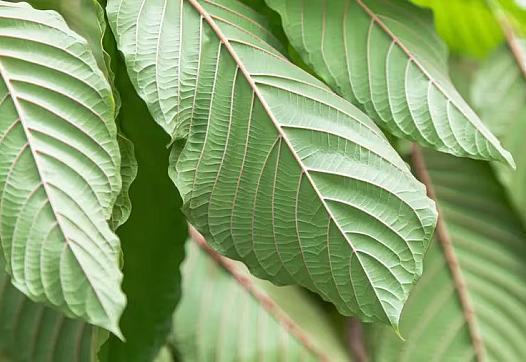Part 1: Hundreds died using kratom in Florida. It was touted as safe.
The story was originally published by the Tampa Bay Times with support from our 2023 National Fellowship.
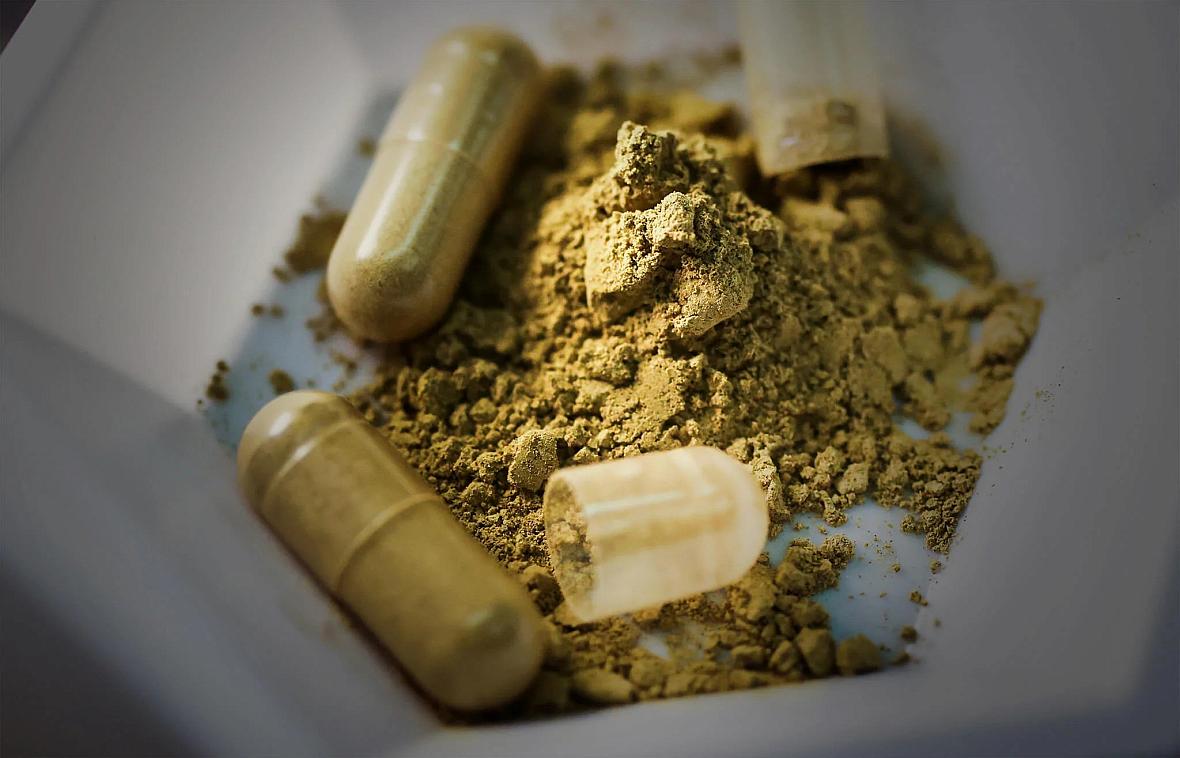
They found him early in the morning: slumped on the couch, vomit on his shirt, face pale, eyes halfway shut.
A roommate told paramedics he feared Jonathan Dampf had relapsed on painkillers and overdosed. This time, though, the 33-year-old had taken something new.
Dampf came to Florida more than a decade earlier in the throes of addiction. Alcohol, pills, anything he could get his hands on.
Within months, he got sober and became a leader at his Fort Lauderdale church’s recovery program. He married and had a daughter.

Jonathan Dampf, Kristi Krause and their daughter Evannah in 2021. That year, Dampf died in their Broward County home after taking kratom, a psychoactive substance widely available across Florida.
Courtesy of Kristi Krause
He was everything to them. His wife had his number saved in her phone as “Superman.”
But life’s pressures became suffocating. His daughter was born with a condition requiring around-the-clock care. His home needed repairs. Bills added up. Depression took hold.
He decided to try kratom, a dusty green psychoactive powder from the leaves of a Southeast Asian tree. It was marketed as a safe way to ease anxiety and mimic the effects of opioids. It was legal, virtually unregulated and described as all-natural. He could find it at gas stations, cafes, smoke shops or online.
He took it regularly, including before paramedics were called to his home in April 2021.
Earlier that evening, he streamed “Godzilla vs. Kong” with his wife. She stayed upstairs at their Broward County home, sick in bed, while Dampf watched from the downstairs couch. They pressed play at the same time.
During the movie, Dampf was quiet. He didn’t answer texts. His wife figured he’d fallen asleep.
Hours later, he was gone.
A medical examiner determined he took a lethal amount of kratom. No other substances were detected in his system. His family and friends couldn’t believe it — how could something so available be so dangerous?

Kristi Krause, 32, holds her daughter Evannah in October 2023. Evannah’s dad, Jonathan Dampf, overdosed on kratom. “He did not want to be taking this stuff,” Krause said. “He truly, truly didn’t.”
DIRK SHADD | Times
A Tampa Bay Times investigation found that more than 580 people in Florida have died from kratom-related overdoses during the past decade — even as the industry has touted the safety of its products. Most of the deaths were caused by a fatal mixture of kratom and at least one other substance, but 46 people overdosed solely on the herb.
The Times’ review of kratom’s toll is the first of its kind by a news organization in Florida. Reporters analyzed thousands of pages of autopsy and toxicology reports, police documents and company records. They interviewed over 150 scientists, doctors, policy experts, regulators, industry players, consumers and relatives of overdose victims. Reporters also had 20 kratom products tested by researchers.
Among the findings:
- Companies sell kratom without dosing instructions, a list of ingredients or, sometimes, any label at all — leaving customers to determine product safety on their own. Vendors often brag about the strength of their kratom, marketing powders and liquid shots as “powerful,” “most potent” and “long-lasting.” Yet the majority of products tested by the Times failed to disclose their intensity on labels. One packet of pills was so enhanced a scientist compared it to “legal morphine.”
- At least a fifth of those who overdosed solely on kratom used products manufactured to be more concentrated than traditional, fresh leaf forms of the herb. A 39-year-old mother had an alarming level of kratom’s main ingredient in her blood when she was found lying dead next to her baby on the living room floor. Police discovered at least three pouches of kratom powder inside her Palm Beach County home.
- Nine in 10 people who died had a substance in their system that could be harmful when mixed with kratom, including common medications used to treat anxiety or depression. Makers of prescription and over-the-counter drugs must notify consumers about the potential danger of combining their products with other substances. The kratom industry doesn’t have to issue such warnings.
- Kratom companies and lobbyists sell the plant as a safe way to escape opioid addiction, but people with a documented history of drug use accounted for the majority of kratom-only overdoses. More than half of them had misused opioids like oxycodone or heroin. After a car crash shattered his spine, a Port Richey man got hooked on prescription painkillers, then overdosed on kratom while trying to wean himself off hard drugs.
For years, the American Kratom Association, which is the most influential kratom lobbying and advocacy group in the world, has told the public and legislatures across the country that the herb cannot be fatal, unless it’s contaminated or laced with drugs like fentanyl.
C. McClain “Mac” Haddow, the organization’s chief lobbyist, called the Florida death toll “grossly overstated.” He described it as the result of “anti-kratom propaganda.” Underlying medical conditions or other substances may be the real culprits, he said.
Haddow acknowledged that some overdose victims had dangerously high levels of kratom’s major chemical compound in their blood. But he placed the blame for deaths on consumers, saying they used the herb “irresponsibly.”
Millions of Americans take kratom, and the industry is estimated to be worth roughly $1.5 billion. Many consumers laud the herb as an effective way to treat pain, depression and addiction. In Florida, the state’s role in the opioid epidemic — including the shutdown of once-thriving pill mills and a flourishing drug treatment industry — helped create a lucrative market for kratom companies in search of customers.
The federal government tried to ban the substance in 2016 after an uptick in calls to poison control centers. But the American Kratom Association, consumers, scientists and dozens of lawmakers objected to the restrictions, which would have curtailed kratom research and made possession a crime. The U.S. Drug Enforcement Administration abandoned its plan to temporarily make mitragynine, kratom’s main chemical compound, a Schedule 1 substance like heroin or LSD.
Public health officials have recorded more than 2,000 fatal kratom-related overdoses since 2021, according to data collected from 40 states and Washington, D.C. Federal authorities have said there’s no evidence to establish the safety of kratom and have issued an import alert for the herb, meaning arriving shipments could be refused entry onto U.S. soil.
Yet little else has been done to regulate kratom at the national level.
Scientists believe kratom’s chemical compounds show therapeutic promise. Some want to use the herb to create a gentler treatment for opioid addiction and a painkiller that comes with a lower risk of overdose than medications on the market. Many also view kratom as a safer alternative to drugs like fentanyl, which claim tens of thousands of lives each year.
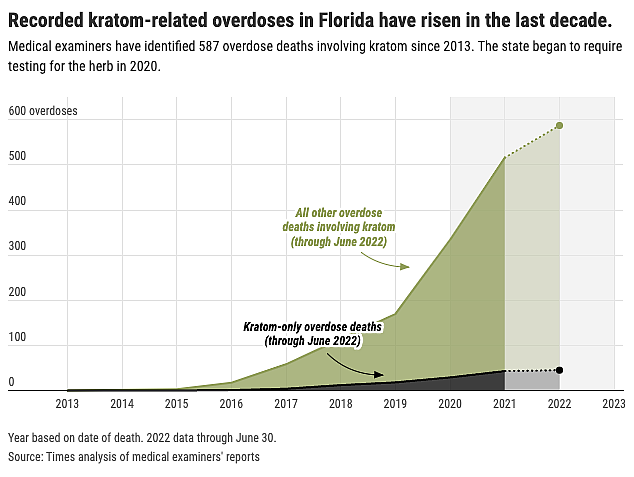
But much remains unknown about how to safely consume kratom and whether taking it could lead to long-term effects. Scientists are working to determine safe doses and to better understand why people die. Consumers face a vacuum of definitive scientific information about the plant, which has been linked to seizures, increased heart rates and liver injuries.
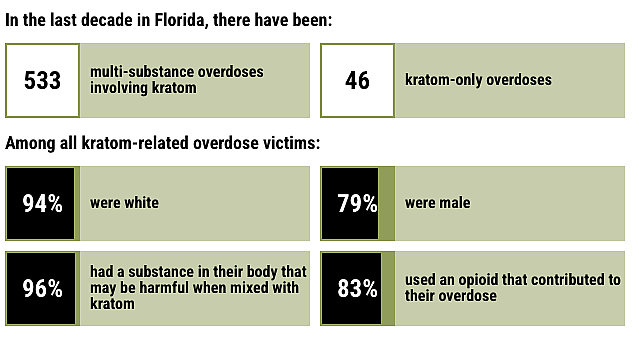
In recent months, wrongful death lawsuits filed against kratom companies have drawn national attention. A jury in southern Washington state handed down a multimillion-dollar verdict, and in Florida, a Palm Beach County family was awarded $11 million.
Today, the substance remains widely available across the state. Competing businesses often deploy an array of marketing messages with limited scientific backing.
A shop in St. Petersburg hands out flyers advertising the plant’s “opiate withdrawal relief.” Kava bars, from Gainesville to Miami, sell kratom teas with promises to increase energy or calm nerves.
The claims can be enticing — and impossible to vet.
At first, Dampf believed every word he read, family members said. The narrative he’d found online described kratom as a natural cure for his debilitating anxiety and depression.
But when he tried to wean himself off it, he couldn’t stop. The ensuing headaches and stomach pain prompted him to reach for kratom again.
After coming clean to his wife, Dampf confessed to his boss and lost his job at the recovery program. Crushed and humiliated, he wasn’t sure where to turn.
“We just didn't know what to do,” his wife, Kristi Krause, said. “He did not want to be taking this stuff. He truly, truly didn’t.”
On the morning of his death, she showed police her husband’s stash of kratom in the garage. One package had no dosing instructions. Another, next to it, boasted it was the “freshest and most potent in the world.”
Very little knowledge
Kratom has been used for hundreds of years but only started gaining popularity in the U.S. in the 2000s.
It comes from the leaves of a Southeast Asian tropical tree, Mitragyna speciosa, and has been taken to substitute opium, boost the energy of laborers and treat medical issues from diarrhea to diabetes since at least the early 1800s across parts of Malaysia and Thailand. In small amounts, the substance can act like a stimulant with effects that alleviate fatigue, improve stamina and sharpen focus. At higher doses, it more closely mirrors a sedative.
The plant’s best-studied chemical compound, mitragynine, binds to the brain’s μ-opioid receptors, making it similar to painkillers like fentanyl and oxycodone. But it’s not as powerful. Mitragynine and other chemical compounds in the herb, called alkaloids, also interact with serotonin receptors linked to mood enhancement.
People in Southeast Asia chew fresh plant leaves, boil them for tea or use them to make chilled juice. Overdose deaths have not been reported in Malaysia or Thailand like they have in the U.S.
But most Americans consume the herb differently.
Here, kratom is widely available in more concentrated forms, such as capsules and liquid extracts. Dried leaf powder is commonly brewed into teas and mixed with other drinks like coffee or orange juice.
“A lot of consumers out there in America, I believe that they have very little knowledge about kratom,” said Darshan Singh, who studies the plant at Universiti Sains Malaysia. “You just have to follow the traditional approach, and you will not encounter any problems.”
The Times requested evidence photos for every kratom-only overdose death investigated by a law enforcement agency in Florida. Police officers didn’t always document the herb at the scene, but in cases where they did, they mostly discovered powder or capsules.
Reporters purchased 20 kratom products from online vendors, gas stations, smoke shops and other businesses around Tampa Bay and had them tested by researchers at the University of Florida. Eight of the products were the same types as those found at fatal kratom-only overdoses.
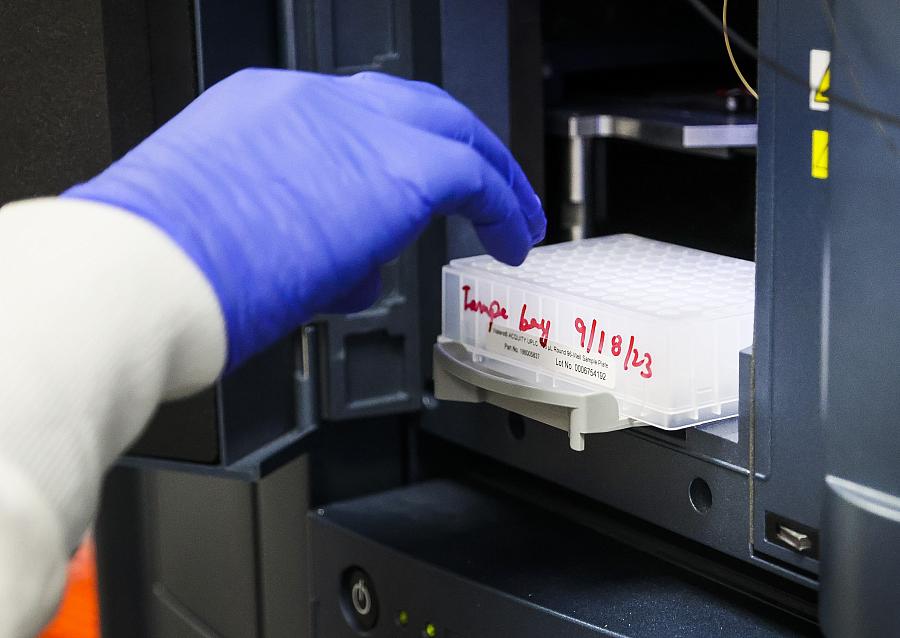
Kratom samples provided by the Tampa Bay Times were tested at a University of Florida lab in Gainesville. Researchers analyzed 20 products, including powders and liquid shots.
DIRK SHADD | Times
Package labels varied widely. Five had no information about ingredients. Eleven had no dosing instructions. Thirteen had no details about potency.
One product shipped by mail arrived coated with a dusty material. The vendor included a complimentary packet of powder with only “Trainwreck” written on it. Another company’s return address was blacked out.
Several of the products tested by the Times contained what experts consider to be high levels of mitragynine and other alkaloids, including one called speciociliatine that companies failed to identify and quantify on package labels. University of Florida researchers believe the alkaloid has more opioid-like effects than mitragynine and could play a role in determining a product’s safety.
A small liquid product bought by the Times, called K Shot Black, contained 114 milligrams of mitragynine and 24 milligrams of speciociliatine. Neither amount was listed on the bottle.
Overall, powders and capsules were far less potent than liquid shots but often came in packages that included large amounts of mitragynine.
The Times tested 12 powders. The strongest per gram was from Remarkable Herbs, which bills itself as the oldest kratom brand in the country. The popular vendor sells bags of leaf powder containing more than 2,600 milligrams of mitragynine. Its products were linked to at least seven fatal overdoses in Florida, involving either kratom alone or the herb and one other substance.
Five of the products bought by the Times were highly concentrated. One was a packet of pills with extreme levels of 7-hydroxymitragynine, a potent kratom alkaloid. The product, 7ΩHMZ, cost $29.99 and came with three tablets.
Abhisheak Sharma, a University of Florida scientist who studies kratom, likened the pills to “legal morphine.”
“This should not be in the market,” he said.
Some concentrated extracts tested by the Times were made by the industry’s biggest names. The pocket-sized vials, filled with a few milliliters of dark liquid, cost roughly $20. They’re displayed near cash registers in gas stations and on shelves at vape shops.
Companies often compete to make the most potent concoction. MIT45, a popular brand, sells an extract called Super K Extra Strong, which it has claimed is the “strongest kratom shot.” Such products, its label says, can be “much more powerful” than regular kratom powder.
The Times tested the extract and found it contained 367 milligrams of mitragynine. That amount is equivalent to over 70 capsules of O.P.M.S. Silver Maeng Da, a popular kratom product linked to at least three deaths in Florida.
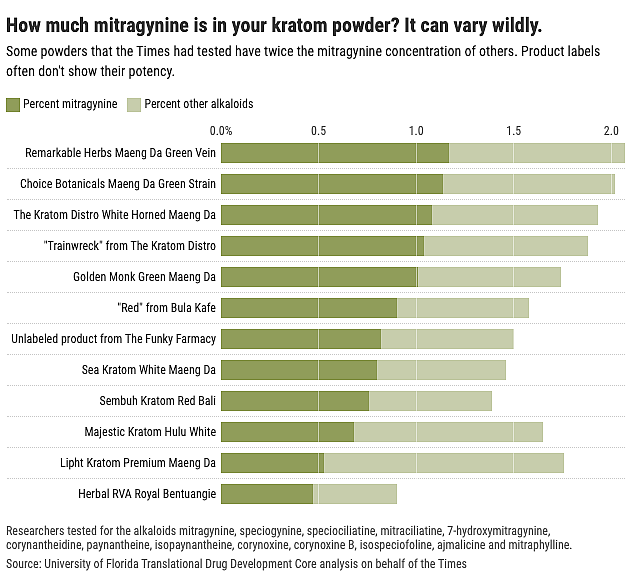

The potent products have captured the interest of scientists trying to understand how — and why — people are dying.
“When you use a concentrated extract, you’re getting a lot more material all at once,” said Christopher McCurdy, a kratom researcher at the University of Florida.
He compared it to “drinking a Miller Lite versus drinking 12 ounces of Everclear.”
McCurdy believes the extracts shouldn’t be sold to people using kratom for the first time. Though some include vague health warnings on their packaging, the instructions are written in tiny type that can easily be missed. Many of the products come in bottles that are smaller than single-serving energy shots.
The little kratom vials, Sharma said, can contain several times more mitragynine than he thinks is safe to consume over an entire day.
Police found three bottles of O.P.M.S. Gold Liquid, a potent extract, at the scene of Ellen Benditcha’s death last year. A medical examiner later determined the 58-year-old Broward County woman had taken a fatal mixture of kratom, antidepressants and medications used to treat anxiety and epilepsy.
Some online retailers selling the extract suggest using just a drop or two. But the vials provide no serving size.
Inside Benditcha’s bedroom, two bottles were empty.
Alarming levels
Tracking kratom-related deaths in Florida is fairly new. The state required medical examiners to record cases starting in 2020 after a University of Florida toxicologist recommended it. But many had already begun looking for mitragynine as part of toxicology testing.
Overdoses attributed to kratom alone, or in combination with other substances, took off across Florida after 2016.
The Times requested Florida autopsy reports since 2010 that cited kratom or its most prominent ingredient as a cause of death or contributing factor, analyzing cases deemed accidental overdoses.
Orange, Palm Beach and Broward counties had the highest death tolls. When adjusted for population, several counties near or on the state’s Treasure and Space coasts saw the worst overdose rates, with Okeechobee, Martin and Volusia as the top three.

Of the 587 kratom-related overdoses through June 2022, medical examiners identified 38 in Tampa Bay, including eight from the herb alone.
The Times shared autopsy and toxicology data from kratom-only overdoses with four independent pathologists and kratom researchers. They noted variations in how people died. Some of the overdoses looked more like those caused by stimulants, with victims suffering sudden cardiac issues. Others resembled deaths attributed to opioids, with people experiencing too much fluid in their lungs and swollen brains.
Fourteen people who overdosed solely on kratom had at least one medical problem listed as a contributing factor. Five had heart disease. Companies generally aren’t required to warn consumers about whether existing medical conditions could put them at increased risk when taking the herb.
Scientists haven’t yet agreed on a fatal dosage for kratom.
Among kratom-only overdoses, about half involved people who had what experts described as alarming levels of mitragynine in their system: concentrations higher than 1,000 nanograms per milliliter of blood.
A 28-year-old St. Augustine man had a blood-mitragynine concentration of 2,500 nanograms per milliliter. His ex-girlfriend found him on the living room floor.
A 56-year-old Miami Beach woman had a blood-mitragynine level of 4,300 nanograms per milliliter. A co-worker found her inside a T.J. Maxx break room.
A 46-year-old Delray Beach man had a blood-mitragynine concentration of 7,182 nanograms per milliliter. His roommate discovered him on the bathroom floor.
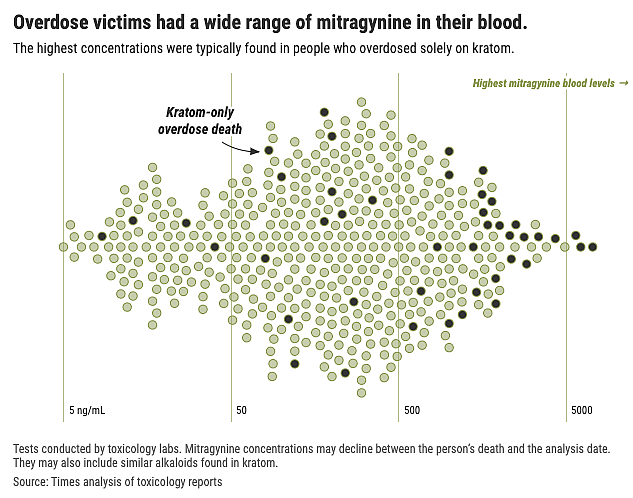
Toxicology labs test for mitragynine because it’s the best-studied alkaloid in kratom. Scientists are still working to determine whether mitragynine itself is to blame for deaths or if another alkaloid is the problem.
How chronic kratom use affects people also remains unclear.
Florida poison control centers logged 450 calls reporting concerns about the herb from 2017 to May 2023. Across the country, more than 5,200 calls occurred during the same period.
Studies using poison control data have shown harmful symptoms include agitation, increased heart rates and seizures.
In the deaths reviewed by the Times, 10 people who overdosed solely on kratom had previously suffered at least one seizure. Four had an apparent seizure when they died.
At least two people started experiencing seizures after they began using the substance, according to their families.
Jessica Speranza was one of them. To help with chronic pain, the 30-year-old tossed back spoonfuls of kratom powder with a chaser.
Her roommate told police he brought her Bali Red kratom powder from a kava bar in St. Petersburg where he worked. Speranza, who had a history of using drugs, developed a high tolerance and didn’t show adverse side effects, he said.
But her mother saw something different. After her kratom use started, so did her seizures, Linda Speranza told the Times.
The seizures became more frequent. Her health deteriorated. She’d tremble. Sometimes, she could hardly walk.
“The more seizures she was having,” her mother said, “the more kratom she was taking because she was in pain.”
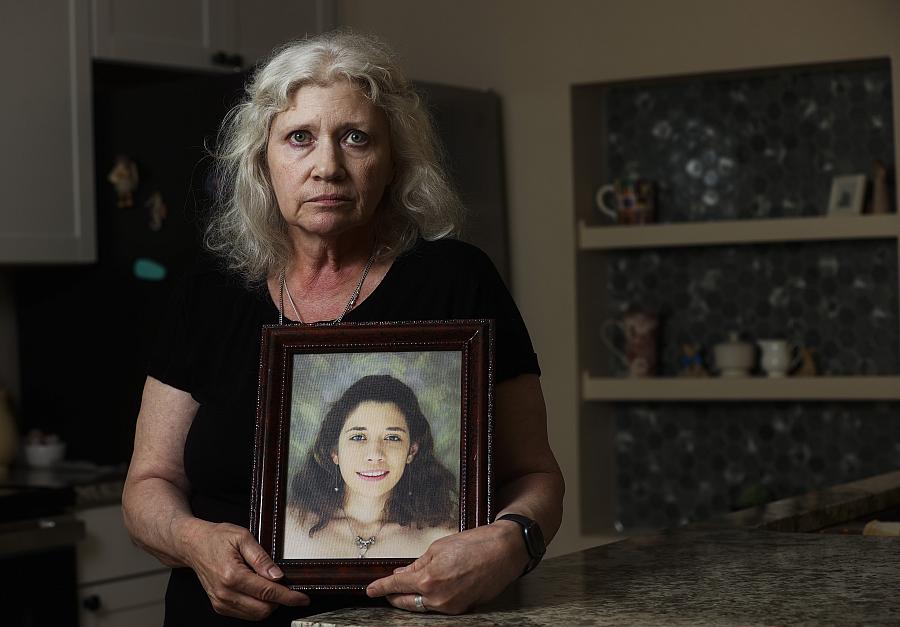
Linda Speranza holds a portrait of her daughter, Jessica Speranza. Linda said her daughter started having seizures after she began taking kratom.
DIRK SHADD | Times
She was rushed to the hospital multiple times. But doctors couldn’t identify the cause of her seizures, her mother said. Further tests were scheduled in the summer of 2021.
But before she could go, Speranza had another seizure, overdosed on kratom and died.
Deadly mixtures
The warning consumers receive about the potential danger of combining kratom with other substances depends entirely on the brand. There are no rules, either in Florida or at the federal level, requiring that companies alert people to the risk.
More than 530 people in Florida died from mixing kratom with one or more substances. Over three-quarters involved fentanyl. Six died from combining the plant with alcohol.
Medical examiners attributed more than 30 overdoses to a lethal mixture that included kratom and at least one drug used to treat anxiety or depression.
Both prescription and over-the-counter medications must include clear warnings about the potential for interactions with other substances.
The allergy drug Benadryl, for example, says on its packaging that mixing tablets with alcohol may increase drowsiness. Tylenol warns about consuming its product while drinking because of the risk of severe liver damage.
Twelve of the 20 kratom products tested by the Times had no warnings on their packages about potential interactions with prescription medications or other substances.
Ten products had disclaimers telling consumers to consult their doctors before using kratom.
Three products provided specific disclosures, including the K Shot Black extract, which warned customers not to combine it with alcohol, large amounts of caffeine or other stimulants, prescription drugs or illicit substances.
The main danger of mixing kratom with drugs lies in how the body processes the substances.
Research has shown that kratom can slow certain enzymes in the intestine and liver as the body works to flush the herb’s alkaloids out of its system. The enzymes break down thousands of medications and illicit drugs: antipsychotics, anti-anxiety pills, cocaine and opioids such as oxycodone.
The enzymes act like revolving doors with drugs passing through them. If mitragynine, for example, blocks one of the doors as it’s moving along, another substance could build up in the bloodstream. Over time, it could become toxic.
Those consuming large amounts of kratom are likely at higher risk, experts say.
“People see this as some random supplement,” said Albert Garcia-Romeu, a kratom researcher at Johns Hopkins University. “They don’t know how much to take, and they don’t know how it works, and they don’t know that it might mess with their medications.”
At least one kratom brand, O.P.M.S., has warned consumers to ask their doctors about “enzyme inhibition” in a lengthy disclaimer on its website. The language was not included on product packaging reviewed by the Times.
Desperate to understand how to take kratom safely, Jonathan Roby would devour videos and forums online.
The 38-year-old Navy veteran sought a natural route to treat his post-traumatic stress and crippling anxiety, his girlfriend said. He wanted to replace his antidepressants and anxiety medication, prescribed by the U.S. Department of Veterans Affairs.
Roby started to increase his kratom dose while taking his prescriptions — not knowing the combination could be fatal.

Jonathan Roby, a Navy veteran who lived in Deltona, turned to kratom to treat post-traumatic stress and anxiety.
Courtesy of Candis Roby
Just before sunrise one day in June 2021, Roby started convulsing inside his Deltona home. Cardiac arrest followed.
A medical examiner determined he died from mixing kratom with venlafaxine, a common antidepressant. Heart problems, liver disease and obesity were contributing factors.
Kratom may also add to the danger of opioids like fentanyl when they're combined, said Mary Paine, a researcher at Washington State University who studies interactions between kratom and other substances. Fentanyl is mostly broken down by one of the enzymes that the herb can slow.
Japheth “Jay” Rhodes, a former combat engineer in the U.S. Army Reserve, started using kratom to get off hard drugs — but wound up taking them together.
Rhodes was supposed to deploy to Afghanistan in the late 2000s, but he injured his knee during training. He started taking oxycodone and became addicted.
“He tried everything he could to stay clean,” his mother, Sheryl Rhodes, said. “He told me he got on kratom.”
He said it was helping.
“It’s all natural, Mom,” he told her. “It balances me out.”
But eventually, he relapsed.
A week before his 41st birthday, in December 2020, his mom and wife discovered him inside the bathroom of his Myakka City home. A medical examiner found he had a large amount of mitragynine in his system along with fentanyl. The mix was enough to kill him.
Seeking a salve
Ask someone why they use kratom and the specifics vary. But often, there is a common theme: to self-medicate and soothe an ailment.
For many, it’s to deal with symptoms of opioid withdrawal or cravings.
Federal law prohibits kratom companies from making medical claims because the substance is not an approved drug. But the herb is often marketed as a way to treat anxiety, pain and opioid addiction. Online, for example, a vendor called Phoria said people can use kratom to “step down off of dangerous prescription drugs.” (The company recently removed the language from its website.)
A car crash had left Jason Lay with a shattered spine and years of painkiller addiction.
“His whole back was plates and rods,” his sister, Nicole Zambetti, said. “He was in a ton of pain, so then came the opiates.”
Lay tried to switch to over-the-counter medication like ibuprofen, but his stomach bled so severely it almost killed him. He went back to opioids before turning to kratom.
Many products don’t come with instructions for how to treat opioid addiction. And in October 2020, 44-year-old Lay took too much of the herb inside his Port Richey home.
Lay is among at least 135 people in Florida who overdosed on kratom after previously struggling with drug use, the Times found. Eight died while they resided in sober living settings.
Selling to people who’ve used opioids contributed to kratom’s rise.
The crackdown on pill mills a decade ago in Florida helped create a customer base looking for alternatives to prescription painkillers. In that climate, kava bars that sold kratom began to blossom. The herb’s popularity also grew.
“We did see a huge growth during the opioid epidemic,” said Nick Bauer, an industry consultant who manages a kava bar in the Miami area.
“I think (that’s) what made it so big, especially in South Florida,” Bauer said. “Here’s an alternative: you can stop doing ‘blues,’ you can stop doing ‘Roxys.’ You can go get a tea and feel so much better.”
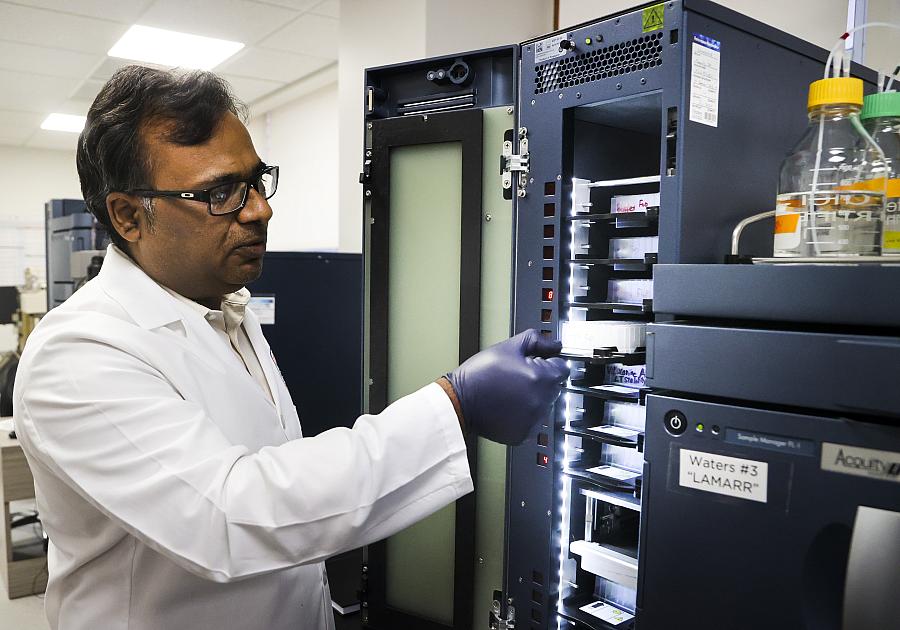
University of Florida researcher Abhisheak Sharma, seen here with testing equipment, is concerned about highly concentrated kratom products.
DIRK SHADD | Times
Many in recovery from opioid use, like Tyler Rook, say kratom is the only thing keeping them from slipping back into addiction. The 31-year-old Tampa resident overdosed on heroin two years ago and now uses kratom daily.
“When you stop drinking and you stop doing drugs,” he said, “when you’ve almost seen death — it looks like coffee in the morning.”
The American Kratom Association has maintained that banning kratom would worsen the opioid epidemic, driving people to use dangerous drugs. The organization has cited a widely circulated study from Johns Hopkins researchers, who surveyed more than 2,700 people who use kratom.
The scientists turned to the kratom association and sites like Reddit to recruit study participants. They found that 4 in 10 consumed the plant to stop or limit opioid use. The vast majority said kratom effectively alleviated withdrawal symptoms.
Pain, though, was the most common reason people took the herb. And almost two-thirds said they were treating depression.
At least one product warns against doing that.
K Shot Black tells consumers on its bottles: “Do not try if you have a history of mental illness.”

Kava bars selling kratom helped pave the way for the herb’s success across the state. In the early 2010s, as kava bars boomed, kratom’s popularity also grew.
AYA DIAB | Times
The Times found that at least 19 people who overdosed on kratom alone had struggled with their mental health, including with depression or post-traumatic stress disorder.
Luke Larsen was seeking a salve for his anxiety, his family believes.
The same mind that helped the 27-year-old nurse excel throughout school had betrayed him, and during the pandemic, Larsen’s anxiety and depression surged. He moved back home to Valrico from his master’s program at Johns Hopkins.
By August 2020, though, Larsen seemed to improve. He’d let his anti-anxiety medication run low and planned to start work as a nurse in Asheville, North Carolina. Weeks before he was supposed to move, he texted a fellow nurse a map of all the places they’d Frisbee-golf in the city.
The next day, his mother found him dead sitting at his computer, his limbs rigid and askew.
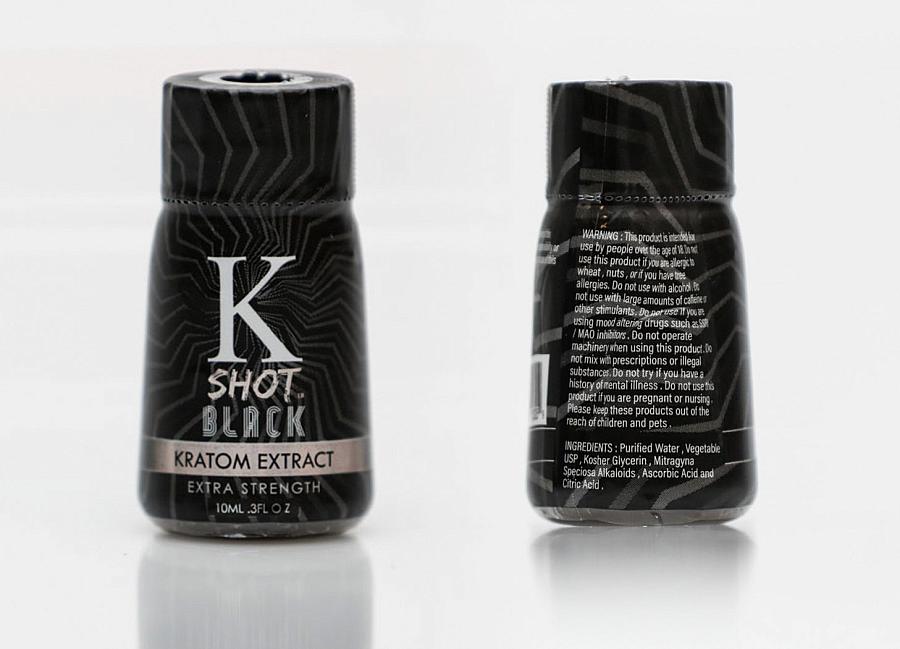
The K Shot Black extract warns customers not to combine it with certain substances, including alcohol and prescription drugs. The liquid shot contains 114 milligrams of mitragynine and 24 milligrams of speciociliatine, but neither amount is listed on the bottle.
JEFFEREE WOO | Times
So many questions raced through Karen Larsen’s mind.
But the biggest one was: Why?
Karen Larsen at first believed her son died by suicide. In the days and weeks after his death, his parents searched for a reason. A medical examiner determined he accidentally overdosed on kratom. No other substances were found in his system.
His parents didn’t know anything about kratom, so they initially weren’t sure what to make of the bag filled with green capsules labeled O.P.M.S. Silver or the packages of Choice Botanicals kratom powder they’d found on his desk after he died. They figured the substance was just another one of his supplements, sitting next to a bottle of turmeric.
But a simple internet search revealed the herb’s possible appeal. Online, health claims about kratom’s power to treat anxiety abound.
It takes control
One of the central arguments made by supporters of the kratom industry is that the plant isn’t dangerously addictive.
Haddow, the kratom association lobbyist, has acknowledged that dependency is possible. But he called it “vastly different” from opioid addiction, likening the experience to consuming a “benign” substance like caffeine.
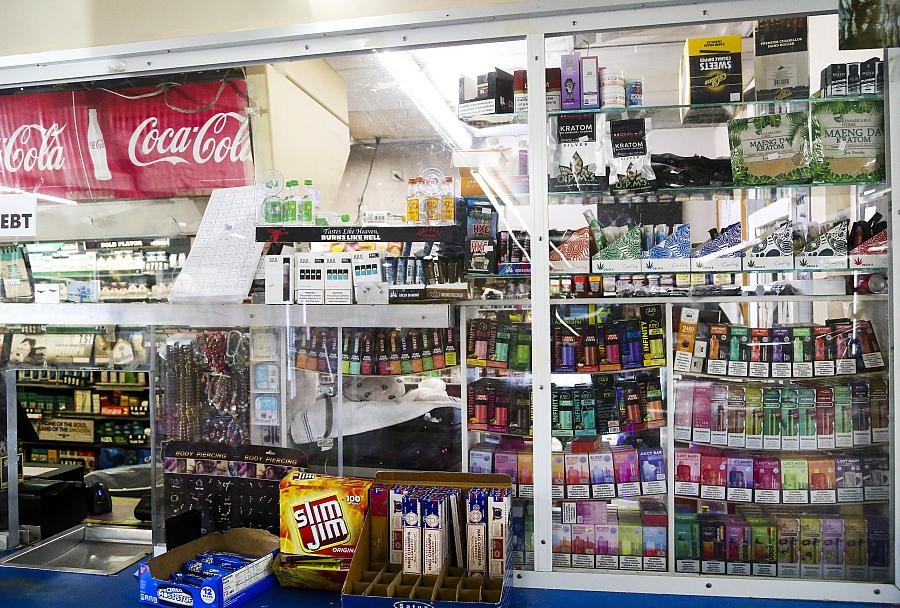
Karen and Zayne Larsen hold a photo of their son, Luke, who died in their Valrico home after using kratom. He was 27.
DIRK SHADD | Times
Online forums with thousands of people who use kratom say the same. One commenter praised the herb as “no more addictive than coffee.” Others described mild withdrawal symptoms, ranging from a runny nose to headaches. But threads on Facebook and Reddit also include pleas from those looking for tips on how to quell their addictions.
There are complaints of debilitating withdrawals. Of bank accounts drained and families torn apart.
For many, escaping one addiction only means falling into another.
“These days, kratom and opioid dependency go hand in hand,” said Andrea Raab, the program supervisor at Nextep, an outpatient substance use provider with locations in Southwest Florida. “We’re seeing a lot of people using kratom to get off opioids, not realizing just how addictive it is.”
Withdrawal symptoms from kratom can mimic those typically experienced with stimulants or opioids, such as chills, nausea, insomnia, irritability and restless legs syndrome.
Researchers say a person’s level of dependency relates to how much kratom they consume. Two products bought by the Times, powders from Lipht Kratom and Sembuh Kratom, had labels warning that “prolonged use” could be habit-forming.
The Johns Hopkins survey found that a small percentage of kratom consumers experienced withdrawals, which were typically mild. But such studies, scientists say, can skew toward enthusiasts deciding to participate. Animal research suggests that tea made from kratom leaves produces less dependence than opioids like morphine.
Some people start consuming large amounts of kratom after developing tolerance, said McCurdy, the University of Florida researcher. Then, when they stop taking the herb, they get sick.
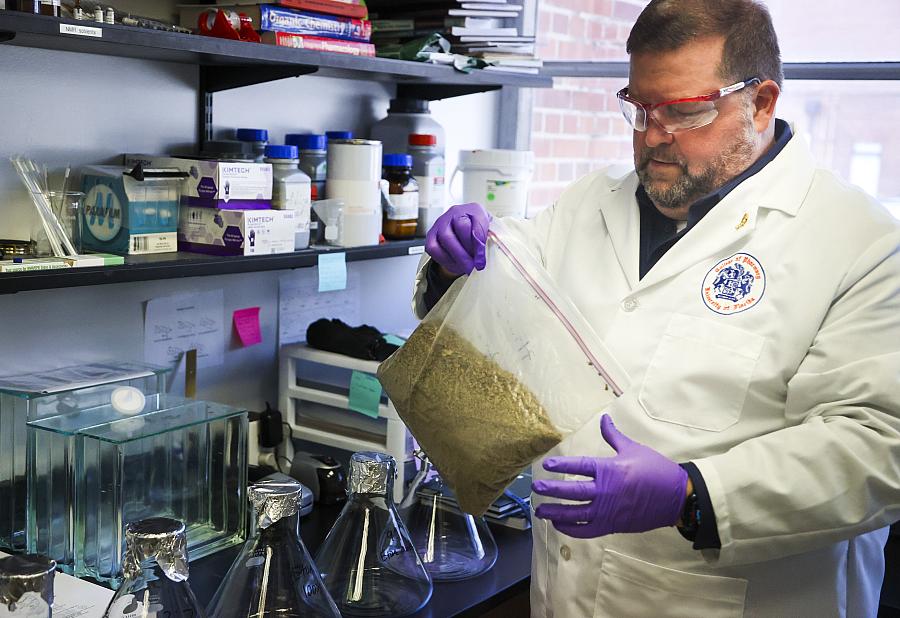
University of Florida researcher Christopher McCurdy holds a bag of ground kratom leaf in Gainesville.
DIRK SHADD | Times
The Times surveyed a dozen substance use providers in Florida about kratom treatment. The majority said they’ve noticed an increase in patients seeking help for kratom use over the last five years, often in combination with other substances. But some were in recovery from the herb alone.
There is no widely recognized diagnosis or treatment plan for “kratom use disorder.” But most of the providers said they treat kratom patients as if they’re experiencing a form of opioid use disorder, prescribing drugs like Suboxone, which can ease the effects of withdrawal.
“A lot of people are very unaware that it’s something that can require detoxed medical intervention, because it’s not marketed as something really that’s dangerous,” said Frank Galimidi, chief clinical officer at Sunset House Inc., a treatment center in Palm Beach Gardens. “I've seen people legitimately get themselves thrown out of treatments, or out of halfway houses, spend all kinds of money that they don't have to continue getting kratom, because they do become physiologically and psychologically dependent.”
After Jay Bankston pulled a muscle in his rotator cuff, a friend suggested he try kratom.
It was “basically OxyContin or heroin in a liquid shot,” the friend explained, but with one difference: You couldn’t get addicted.
It had been roughly 10 months since Bankston’s last drink. Exercise dulled the then-32-year-old’s urge for alcohol, but his success felt fragile.
The friend said kratom shots had the most powerful effects and one brand was king: O.P.M.S. Its extract vials cost $20.
After the first shot, Bankston knew he was in trouble.
The pain in his shoulder evaporated. He felt a rush of euphoria. One shot gave him enough energy to carry him through shifts as a truck driver. But within weeks, the amount he relied on to start his morning wasn’t getting him past lunchtime.
As he developed a higher and higher tolerance, Bankston was taking four to six kratom shots a day. Without them, withdrawal symptoms struck within hours: crippling nausea, digestive distress, muscle aches, sleeplessness.
Bankston began spending more and more — sometimes upward of $100 a day — to fuel his habit. His wife thought he was drinking again. Soon, they were living paycheck to paycheck.
His wife threatened to leave if he didn’t quit. He couldn’t.
“It takes control of your entire life when it gets to that point,” Bankston said. “Everything revolves around it.”
Bankston and his wife eventually divorced, and he moved out. For five years, he struggled to stop using kratom — he’d quit and then relapse, quit and then relapse, again and again.
“That’s how powerful this stuff is,” said Bankston, who’s since found a sober living community in Pensacola. “I beat alcohol the first try successfully. But this stuff just took me down.”
Bankston said he hasn’t had a drink since Thanksgiving Day 2017.
He’s tried to quit kratom 10 times. He’s hoping this time will be his last.


